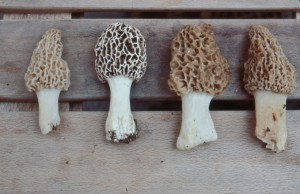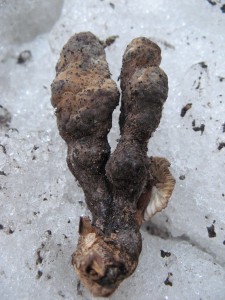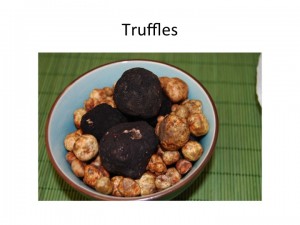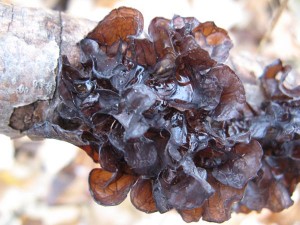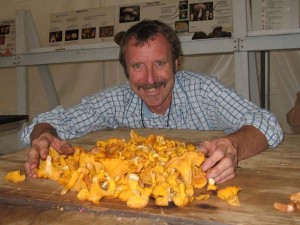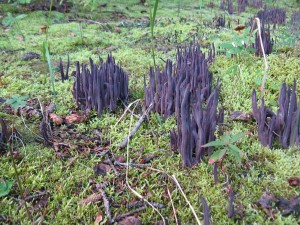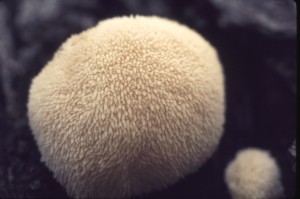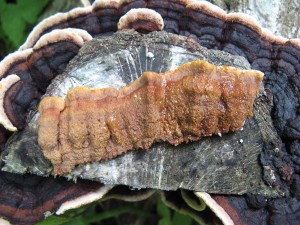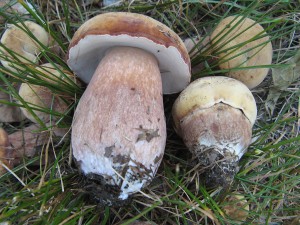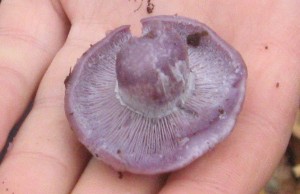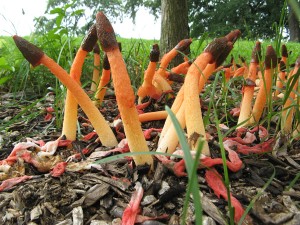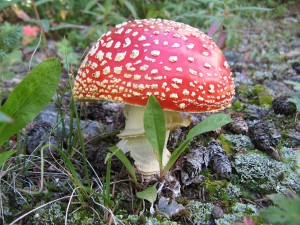BASIC MUSHROOM ID and METHODS (Gary Lincoff 2017)
Basic Equipment for field collecting…..
Basket Waxed Paper
Knife Hand-lens
Camera Tape Measure
Ammonia Hard Candy
Note cards pens/pencils
Basic Equipment for advanced study of mushrooms at home.….
Reference materials – field guides, monographs, websites
Dissecting Microscope
Compound Microscope
Slides and Cover Slips
Single-edge razor blades
Ammonia and KOH
Meler’s Reagent (sometimes iodine will work)
Other reagents include: FeSO4, Cotton Blue, Congo Red
Dryer
Reference Websites:
Mykoweb.com
MushroomExpert.com
NEMF.org – click on NEMF Databases
Methods for collecting in the field…..
- Note down substrate and habitat of mushroom
- Collect entire specimen – use a knife to extract
- Measure / Smell / Cut in half & check for color change
- Make a Spore Print, especially for gilled mushrooms
- Take photos in situ, top & underside
- Use field guides, etc. to look for your mushroom
The mushrooms we find can be sorted into the following field-based groups. (This is now understood to be an artificial classification because these mushrooms represent spore-bearing adaptations rather than evolutionary lineages.)
[For field, see Audubon Society F. G. to North American Mushrooms]
[For evolutionary lineages, see Clade Chart, – see above “My Blog”
[also, see “Sam’s Corner: The Public Journal of a Mushroom Guru,” $20
ASCOMYCETES
CUP FUNGI (“Discomycetes”) includes cup & cuplike fungi, morels, false morels, saddle fungi, earth-tongues…..also lichens
[See: Seaver, “Cup Fungi” (2 volumes) – also on Mykoweb.com]
—————————————————————————————————–
FLASK FUNGI (“Pyrenomycetes”) includes Dead Man’s Fingers, Cordyceps, black dots, crusts and bumps on wood…..
[See: “The North American Pyrenomycetes” by Ellis & Everhart]
——————————————————————————————————-
HYPOGEOUS FUNGI includes truffles, true & false
[See: “The Non-Gilled Fleshy Fungi” by A. H. Smith]
——————————————————————————————————–
BASIDIOMYCETES
JELLY FUNGI includes wood-ears, witches’ butter, jelly tooth, coral jelly, cuplike jelly – Jellies can be cuplike, coral-like, tooth-like, brain-like, etc.
[See: “The Non-Gilled Fleshy Fungi” by A. H. Smith]
———————————————————————————————————
CHANTERELLES & BLACK TRUMPETS: Canthraellus & Craterellus
[See: “The Non-Gilled Fleshy Fungi” by A. H. Smith]
——————————————————————————————————-
CORAL FUNGI includes Clavaria, Ramaria, etc. [See: “The Club and Coral Mushrooms of the United States & Canada by W. C. Coker]
——————————————————————————————————-
TOOTH FUNGI includes Hydnum, Hericium, Hydnellum, and tooth or hydnoid look-alikes [See: “The Non-Gilled Fleshy Fungi” by A. H. Smith]
——————————————————————————————————–
CRUST & PARCHMENT FUNGI includes spread-like fungi covering wood, and Stereum [See: “The Thelephoraceae of North America” by E. A. Burt]
———————————————————————————————————
POLYPORES includes 100+ pore fungi on wood [See: “The Polyporaceae of the United States, Alaska, and Canada,” by Overholts]
——————————————————————————————————-
BOLETES includes 100+ pore fungi on ground
[See: “The Boletes of Michigan” by A. H. Smith]
——————————————————————————————————–
GILLED MUSHROOMS includes a vast array of fungi on various substrates, in diverse habitats.…also cyphelloid fungi (e..g., Merismodes)
[See: field guides, websites, apps, / See Appendix in Audubon Guide]
——————————————————————————————————
PUFFBALLS includes small and giant puffballs, false puffballs, earthstars, bird’s nest fungi…..[See: “The Gasteromycetes of the Eastern United States & Canada,” by Coker and Couch]
——————————————————————————————————-
STINKHORNS includes Phallus & Mutinus, etc.
[See: “The Non-Gilled Fleshy Fungi” by A. H. Smith
————————————————————————————-
SOME MUSHROOMS THAT LOOK LIKE WHAT THEY’RE NOT
CUP FUNGI
Guepiniopsis (Jelly), Trametes conchifer (Polypore), Cyathus (Bird’s Nest), Merismodes (cyphelloid agaric), Cladonia (Lichen)
CORAL FUNGI
Calocera (Jelly), Tremellodendron (Jelly), Mucronella (Tooth Crust), Leotia (Asco), Microglossum (Asco), Xylaria (Asco)
TOOTH FUNGI
Pseudohydnum (Jelly), Trichaptum biforme (Polypore), Irpex (Polypore), Hydnochaete (Crust), Sarcodontia (Crust)
BOLETES
Boletopsis (Polypore), Polyporus radicatus (Polypore)
GILLED MUSHROOMS
Schizophyllum, Plicaturopsis, Cantharellus, Lenzites betluina (Polypore)
—————————————————————————————
BETWEEN GENUS AND SPECIES…….
One of several ways to divide these 4 huge genera into recognizable units, each with several to many species…….
Habitat: All are Ectomycorrhizal with oak, beech, birch, conifers.
Note: Each genus is based on something called a “type species,” which in turn is based on a “type collection” deposited in a herbarium that is accessible for specialists to study. Every species included in a given genus is thought to be more closely related to its type species than to the type species of any other genus. Within a genus, the species most closely related to the type species are contained with that section of the genus. Every other section of the genus, with its species, are thought to be more closely related to the genus it’s placed in than to any other genus already described. Sometimes a new genus is described for a species thought to be distinctly different from any published genus.
The Genus Amanita
AMANITA (Spore print White; Gills “free”; UV +; PV + or -)
—–
Section CAESARIA…..cap margin striate, volva well-formed, ring present
e.g., A. jacksonii
Section VAGINATA…..cap margin striate, volva well-formed, ring absent
e.g., A. vaginata
Section AMANITA…..cap margin striate, usually covered with UV warts, volva minimal or cuplike or rows of tissue, ring present
e.g., A. muscaria, A. crenulata, A. frostiana, A. pantherina
(Amanita muscaria is the type species of the genus Amanita)
Section AMIDELLA…..cap margin striate or not, with UV warts, volva well-formed, ring present or not
e.g., A. peckiana, A. volvata
Section PHALLOIDES…..cap margin not striate, usually adorned with single white patch from UV, volva well-formed, ring present
e.g., A. bisporigera, A. phalloides [DEADLY]
Section VALIDAE…..cap margin not striate, cap adorned with patches from UV, volva patchy or hard to discern about swollen stem base, ring present
e.g., A. brunnescens, A. citina, A. flavoconia, A. flavorubescens, A. rubescens
Section LEPIDELLA…..cap margin not striate, cap white to gray and conspicuously adorned with UV patches, volva often hard to discern about swollen or turnip shaped stipe base, ring present or remnants about cap margin
e.g., A. abrupta, A. cokeri, A. onusta, A. daucipes
————————————————————————————-
The Genus Cortinarius
CORTINARIUS [Spore Print: Rusty Brown; Cortina +)\
—–
Section MYXACIUM…cap & stipe slimy; stipe slender
e.g., C. iodes, C. trivialis, C. vibratilis
Section PHLEGMACIUM…..cap slimy, stipe dry; stipe clav to abrupt bulb.
e.g., C. multiformis, C. glaucopus
Section SERICEOCYBE…..cap & stipe dry; blue or blue-gray, fragrant
e.g., C. alboviolaceus, C. camphoratus, C. traganus
Section LEPROCYBE…..cap, gills & stipe orange, often with greenish tint,
hygrophanous…..e.g., C. orellanus (DEADLY), C. bolaris
Section DERMOCYBE…..cap, gills & stipe orange to reddish, small, not
hygrophanous; pigments bleed in butter
e.g., C. cinnabarinus, C. semisanguineus
Section TELAMONIA…..cap hygrophanous, brown fading, often small
e.g., C. acutus, C. armillatus, C. flexipes
Section CORTINARIUS….cap & stipe dark purple, dry, cap roughened
e.g., C. violaceus ( type species of genus Cortinarius)
————————————————————————————
The Genus Lactarius
LACTARIUS [Spore Print: White to orange; Latex present when cut)
—–
Section “DELICIOSUS”…latex colored orange, red, blue
e.g., L. deliciosus, L indigo, L. subpurpureus
Section “VOLEMUS”…..latex white, abundant, someitmes staining gills
e.g., L. corrugis, L. hygrophoroides, L. volemus
Section “LIGNYOTUS”…..latex white becoming reddish; cap & stem brown
e.g., L. gerardii, L. lignyotus
Section “CAMPHORATUS”…..latex white to watery; cap surface in some concentrically zoned; odor fragrant in some; acrid or not
e.g., L. aquifluus, L. camphoratus, L. peckii, L. rufus
Section “PIPERATUS”…..latex white, acrid to hot; cap & stipe white
e.g., L. deceptivus, L. piperatus, L. subvellereus
Section “TORMINOSUS” latex white, acrid, some turning yellow or purple
e.g., L. torminosus (type species of the genus Lactarius)
e.g., L. chrysorheus (latex white turning yellow)
e.g., L. uvidus (latex white turning purple)
————————————————————————————–
The Genus Russula
RUSSULA [Spore Print: White to Cream, Yellow, Ochre]; stem chalklike; mushroom fragile – gills shatter easily on throwing against tree!
—–
Section “COMPACTA”….Cap white to tan, and fleshed; context in some turning red then black, or just black
e.g., R. brevipes, R. compacta, R. nigricans complex
Section “FOETENS”…..Cap yellow to orange; smell fresh often almond-extract, but soon turning foetid.
e.g., R. fragrantissima, R. laurocerasi, R. foetentula
Section “DECOLORANS”…..Stipe typically bruises dark to blackish
e.g., R. decolorans, R. rubescens
Section “VIRESCENS”…..Cap dry, some green, yellow, red; flesh mild/acrid
e.g., R. mariae, R. ochroleucoides, R. parvovirescens
Section “EMETICA”…..Cap slimy to tacky; taste acrid; cap often reddish
e.g., R. emetic (type species of the genus Russula)
——————————————————————————————–
HOW DID THE SLIME MOLDS GET THROWN OUT OF THE KINGDOM OF THE FUNGI, and just what are they anyway?
When the Audubon Guide to North American Mushrooms was being written back in 1980 “slime molds” were included. This was based on the sexual reproductive phase of these slime molds; that is, however they developed, when they came to reproduce it was through the production of spores from spore-bearing structures that seemed similar enough to fungi that they were maintained in a classification of the fungi. Subsequently, what we always knew, that these slime molds had an amoeboid phase in their life cycle, took precedence over their reproductive spore-bearing phase, and so they are classified with the amoebas, in the Protist Phylum Amoebozoa, rather then with the Fungi!
————————————————————————————–
See CLADE CHART on this website’s “My Blog” page
TWO DIFFERENT APPROACHES TO IDENTIFY MUSHROOMS
The centuries-old approach to identify mushrooms is field-based and depends on your senses, your eyes, nose, touch and taste, and the simple ability to describe shapes and measure sizes, as well as know something minimal about habitat and substrate. No technical knowledge is required. Before microscopes came into common use, or easily acquired macrochemicals, like ammonia, became part of the protocol for identifying mushrooms, thousands of different mushrooms had been described by several centuries of close observers of nature. The taxonomic method used here is called morphology – or what you see is what you have.
Contemporary mycology uses a different paradigm to understand the diversity of the mushrooms we are finding. By using microscopy, including Scanning Electron Microscopy, as well as a suite of chemical and reagents to check for both macro and micro color changes, and now using DNA sequencing to help determine how close or how distant two mushrooms are that appear to be related based on their morphology. Many of the new genera of mushrooms are based on this data, that mushrooms that appear to be related by morphology are not necessarily closely related at all. The taxonomic method used here is called cladistics – or finding the underlying connections among field-based dissimilarity.
As an example, a “polypore” is believed to be any mushroom that produces a spore bearing layer of pores (tubes). Boletes and polypores both have this layer but can be easily distinguished from one another. But not so some other mushrooms. The Beefsteak Polypore (Fistulina hepatica) is NOT a polypore because its tube layer is not a connected mass of tubes but a mass of closely set but unconnected tubes (It’s actually what is called a cyphelloid fungus.) Berkeley’s Polypore (Bondarzewia berkeleyi) is a “polypore” BUT it’s actually more closely related to the gilled genus Russula than to other polypores; just as Russula (and Lactarius) are not closely related to many well-known gilled mushrooms, like Agaricus or Amanita.
In fact, the most profound difference between field-based mycology and cladist mycology is that according to the Clades (DNA sequenced data), there are NO polypores, NO gilled mushrooms, NO coral fungi, NO tooth fungi, NO “Gasteromycetes” or puffballs, as such. There ARE mushrooms with gills, or pores, or coalloid or tooth-like fruiting bodies, or puffball-like fungi. Each of the delimited Clades include examples of all these spore-producing strategies. Each Clade is an evolutionary lineage of related fungi that appear to our field-based sense as totally unrelated.
That’s the dilemma we face today. Most mushroom hunters are field-based and wouldn’t have it any other way. Some ambitious and adventurous amateur mycologists are trying to understand and use the new DNA-based genera and species. Professional mycologists involved in taxonomy have been using this paradigm since the 90’s, and have been steadily improving its precision to predict relationship. The value of this work, for example is apparent to anyone involved in discovering new medical therapies. Mushrooms that are morphologically distinct but prove to be closely related might share particular chemistries that promise potential value in treating various illnesses.
For the rest of us, knowing mushroom lineages might seem to be too abstract to be useful, but for all those who once believed that Gomphus (Turbinellus) floccosus was the Scaly Chanterelle, now know that it is not at all related to chanterelles, and shouldn’t be eaten thinking it is, and that all chanterelles are edible!
WHAT ARE THE CLADES SHOWING US ?
GILLED MUSHROOMS…..A century ago all mushrooms that had what we call “gills” were classified together. It was thought they were all more or less related to one another. Now, the so-called “gilled mushrooms” are distributed in 8 recognized CLADES of Basidiomycetes, as follows…………photos can be found in field guides and online…..
Euagaric Clade…….. .Agaricus, Amanita, Clitocybe, Cortinarius
Bolete Clade……… … Gomphidius, Paxillus, Phylloporus
Russuloid Clade…….. Lactarius,Lentinellus, Russula
Thelephoroid Clade… Horakia, Lenzitopsis
Polyporoid Clade…….. Lentinellus, Lenzites,Panus
Hymenochaetoid Clade.. Rickenella
Cantharelloid Clade….. Cantharellus
Gomphod-Phalloid Clade….Gloeocantharellus
MUSHROOMS WITH PORES……Traditionally, we have recognized two groupings of pore fungi – the Polypores and the Boletes. Currently, we find fungi bearing tubes (pores) in six of the eight basidiomycete clades.
Eugagaric Clade…. Fistulina
Bolete Clade Boletus
Russuloid Clade Albatrellus, Bondarzewia
Thelephoroid Clade Boletopsis
Polyporoid Clade Polyporus, Ganoderma, Fomitopsis
Hymenochaetoid Clade Coltricia, Inonotus, Phellinus
MUSHROOMS WITH SPINES (“TEETH”)…..Traditionally, we have recognized a single huge genus called Hydnum to accommodate all those fungi with their spores being formed on the sides of spines (or teeth). Now, these fungi are found to be distributed among all the reported clades of the Basidiomycetes…..
Euagarics Clade Deflexula
Bolete Clade Hydnomerulius
Russuloid Clade Auriscalpium, Hericium
Thelephoroid Clade Hydnellum, Sarcodon
Polyporoid Clade Climacodo, Irpex
Hymenochaetoid Clade Hydnochaete
Cantharelloid Clade Hydnum, Sistotrema
Gomphoid-Phalloid Clade Beenakia



